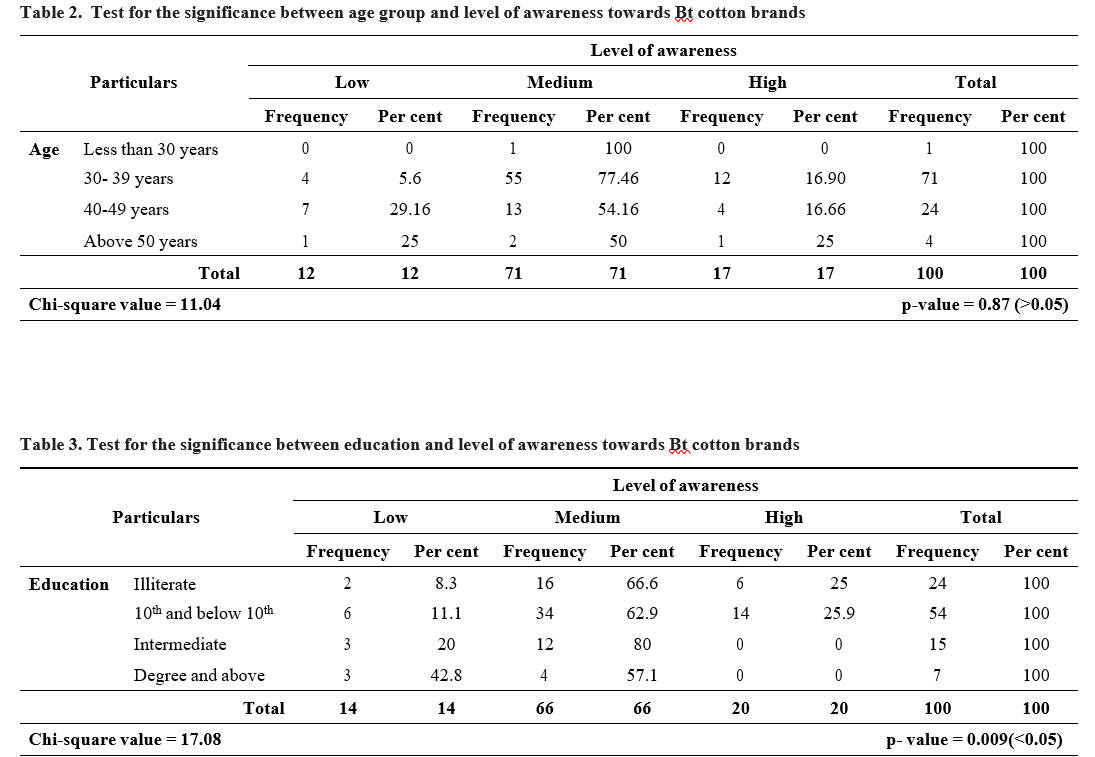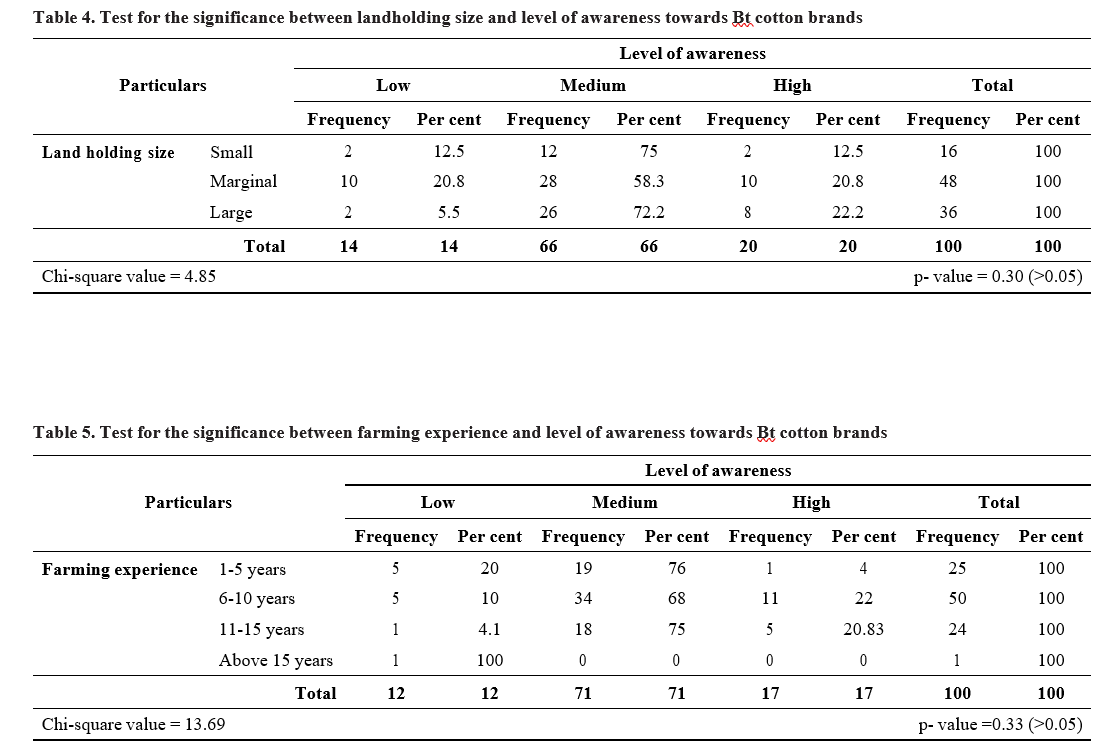Farmers Awareness Towards Different Bt-Cotton Brands in Guntur District of Andhra Pradesh
0 Views
K. SIVA SHANKAR REDDY*, B. APARNA, P. GANESH KUMAR AND P. LAVANYA KUMARI.
Institute of Agribusiness Management, S.V. Agricultural College, ANGRAU, Tirupati-517502.
ABSTRACT
The present study entitled “farmers awareness towards different Bt-cotton brands in Guntur district of Andhra Pradesh” was undertaken mainly to study about the aspects of farmer buying behaviour towards Bt cotton seed. India is 3rd largest producer of cotton with area under cotton crop is 134.77 lakh ha, were as Andhra Pradesh account for 6.57 lakh ha, in A.P., Guntur stands first in terms of production with 9.86 lakh bales and second in terms of area under cultivation with 1,82,000 ha. Guntur district was purposively selected for the study and the top two mandals were chosen which has maximum area and production under cultivation of cotton crop and two villages from each was selected with a sample size of 100 farmers. The selected villages were Gudipudi, Dhulipalla, Mandadi and Veldurithi. There is always a positive relationship between education and awareness of a product. Through Chi square analysis, it was observed that there is a strong association between education of farmers and awareness, also revealed that there is no association between age, income, land holding size with brand awareness. Most of the farmers i.e. 60.26 per cent depended up on the fellow farmers and relatives to select the BT cotton brands, most of the farmers buy the seed from dealers with credit option. Seed regulation authorities should increase the vigilance and ensure the quality of the seed thoroughly before seed certification. Private companies should follow the good CRM to create the more awareness among the rural people.
KEYWORDS: Buying behaviour, awareness level, CRM (customer relationship management), Bt cotton.
INTRODUCTION
Cotton (botanically known as Gosspyium linn; Gossypium arboreum, G. herbaceum, G. hirsutum and G. barbadense) is one of the most important cash and commercial crops of India, which is cultivated throughout the nation. In 2019-20, the area and production of cotton was 365.77 lakh ha and 365.00 lakh bales respectively (Committee on cotton production and consumption 2019-20). Major cotton cultivating states in India includes Maharashtra, Gujarat, Andhra Pradesh, Telangana, which aggregate to nearly 2/3rd of the total cotton grown area. In cotton production, Maharashtra, Gujarat stands first and second followed by Andhra Pradesh and Telangana which are collectively known as ‘cotton basket of India’. (Agricultural Market Intelligence Centre, ANGRAU 2019-20). In India, total area under cotton crop was 134.77 lakh ha out of this Andhra Pradesh account for 6.57 lakh ha that is nearly 5 per cent and India produce 134.77 lakh bales where Andhra Pradesh produce 18.00 lakhs bales which is about 13.35 per cent, Guntur stands with an area of 1,82,000 ha and in production 9.86 lakh bales i.e., 54.77 per cent of total production in Andhra Pradesh. Farmers buying behavior results from individual and environmental influences. It is sum total of consumer’s attitudes, preferences, intentions and decisions on purchasing the product or service and is also complex because each farmer has different attitude towards buying, utilization and disposal of product. Buying behavior is the process where in individuals decide whether, what, when, where, how and from whom to purchase goods and services.
MATERIAL AND METHODS
Andhra Pradesh was selected purposively as the researcher belonged to this state. Guntur district , Guntur district as it always ranked second in cotton cultivation with an area of 83,381 hectare and first in production with 148.89 MT. In the second stage, purposively selected two mandals in the district which had highest area and production of cotton. The selected two mandals in the district were Sattenapalli and Veldurthy with maximum area of cultivation and production of crop. In third stage, villages in each mandal were selected which had highest area and production of cotton. Hence, a total of 4 villages were selected for the study. The selected villages were Gudipudi, Veldurthy, Dhulipalla and Mandadhada. From each village 25 farmers were selected randomly and total sample size of farmers was 100 from four villages of
Table 1. Awareness of farmers towards brands available in study area

selected two mandals.
RESULTS AND DISCUSSION
The study revealed about demographic segmentation of sample farmers, most of farmers were between 30-29 years age group members were about 71 per cent, and 49 per cent educated up to tenth class, most of the sample farmers 85 per cent i.e. with 3 members family size, the average land holding of sample farmers is 5 acres, 94 per cent of farmers occupation is only farming, 81 per cent of farmers with 6-10 years farming experience, the annual income of 81 per cent of the farmers is fifty thousand to one lakh.
It was found that 85 per cent of respondent farmers belongs to small family size, 15 per cent of the respondent farmers belonged to medium family size and none of the respondents have large family size.
Thus, the majority of the respondents had up to 3 members in the family as there are more proportion of small families in the present society which are much aware of leading seed brands and making individual purchasing decision.
Majority of the respondent farmers were medium farmers (up to 5 acres) with 48.00 per cent and 36.0 per cent of respondent farmers were holding above 5 acres, were as only 16 per cent of farmers holding up to 2.5 acres land in study area.
81 per cent of respondent farmers were having 6-10 years of farming experience, followed by 8 per cent of farmers having 1-5 years of farming experience, 6 per cent of farmers were having above 15 years experience.
The major occupation of respondents is only farming i.e. 94 per cent of the total respondents in the study area and 4 per cent of them involved in business enterprises apart from farming.
Awareness of farmers on usage of Bt cotton brands
Based on the brand name and their yields, past experiences of farmers, ten brands were based on the brand name and their yields, past experiences of farmers, ten brands were selected randomly in the study area in order to calculate the level of awareness towards Bt cotton brands. For the analysis, a four point scale (1, 2, 3, 4) were taken as scores which indicates completely aware, moderately aware, aware but depends, unaware respectively. Calculation of mean scores was done and ranking was given accordingly in descending order.
From the Table 1, it was concluded that the level of awareness was high for Khiladi brand with a mean score of 2.95 followed by Kaveri jaadoo and NCS-456 Puja BG-II with mean score 2.79 and 2.72 respectively.
Test for significance between Age group and level of awareness towards Bt cotton brands by sample farmers.
Cumulative scores for the level of awareness were calculated to which three quartile points were taken and grouped as low, medium, and high levels of awareness. A Chi-square test was done to analyze the relationship between the age of sample farmers and their level of awareness towards Bt cotton seeds viz., low, medium, and high. Null Hypothesis (H0): The level of awareness was independent of the age of sample farmers. Alternative Hypothesis (H1): The level of awareness was dependent of the age of sample farmers.From the chi-square test the “p” value was 0.87 which was more than 0.05. This concludes that null hypothesis is accepted i.e. level of awareness towards Bt cotton brands was independent on the age of farmers.
Test for the significance between Education and level of awareness towards Bt cotton brands by sample farmers
Cumulative scores for level of awareness particulars were calculated to which three quartile points were taken and grouped as low, medium, and high levels of awareness. A Chi-square test was done to analyze the relationship between the education of sample farmers and their level of awareness towards Bt cotton brands viz., low, medium, and high Null Hypothesis (H0): The level of awareness was independent of the education of sample farmers. Alternative Hypothesis (H1): The level of awareness was dependent of the education of sample farmers. From the chi-square test the “p” value was
0.009 which was less than 0.05 .This concludes that null hypothesis is rejected i.e. level of awareness towards Bt cotton brands was dependent on the education of sample farmers
Test for the significance between land holding size and level of awareness towards Bt cotton brands by sample farmers
Cumulative scores for level of awareness particulars were calculated to which three quartile points were taken and grouped as low, medium, and high levels of awareness. A Chi-square test was done to analyze the relationship between the land holding size of sample


farmers and their level of awareness towards Bt cotton brands viz., low, medium, and high. Null Hypothesis (H0): The level of awareness was independent of the land holding size of sample farmers. Alternative Hypothesis (H1): The level of awareness was dependent of the education of sample farmers. From the chi-square test the “p” value was 0.30 which was more than 0.05 (Table 4). This concludes that null hypothesis is accepted i.e. level of awareness towards Bt cotton brands was independent on the education of sample farmers.
Test for the significance between farming experience and level of awareness towards Bt cotton brands by sample farmers
A Chi-square test was done to analyze the relationship between the farming experience of sample farmers and their level of awareness towards Bt cotton seed brands viz., low, medium, and high. Null Hypothesis (H0): The level of awareness was independent of the farming experience of sample farmers
Alternative Hypothesis (H1): The level of awareness was dependent of the farming experience of sample farmers. From the chi-square test, the “p” value was 0.33 which was greater than 0.05 (Table 5). This concludes that the null hypothesis is accepted i.e. level of awareness towards BT cotton seed brands was independent on the farming experience of sample farmers
There is always a positive relationship between education and awareness of a product. Through Chi square analysis, it was observed that there is a strong association between education of farmers and awareness, also revealed that there is no association between age, income, land holding size with brand awareness. The result show that education play vital role in the awareness regarding the various brand performance and regarding the product characteristics.
ACKNOWLEDGEMENT
I am very much grateful to the Institute of Agribusiness Management, Tirupati for the financial assistance provided in the form of a stipend during my post-graduate studies.
LITERATURE CITED
Hitesh, R., Jatin, P., Hasumati, S., Patel, G.R and Joshi,
K.M 2017. Farmers buying behaviour of cumin seeds in Banaskantha district of Gujarat state. International Journal of Agriculture Sciences. 9(5): 3767-3769.
Hussain, K.A., Rani, S.U and Murthy, B.R. 2021. Analysis of farmer’s decision towards Purchase of chilli Seed in Guntur District of Andhra Pradesh. Indian Journal of Pure & Applied Biosciences. 9(1): 422-428.
Murugkar, M., Ramaswamy B and Shelar, M. 2007. Competition and monopoly in the cottonseed market. Economic and Political Weekly. 42(37): 3781-3789.
Shravan Kumar, G., Samsai, T and Praveena, S. 2017. Brand preference of farmers and dealers towards Bt cotton hybrid seeds in Guntur district of Andhra Pradesh. International Journal of Commerce and Business Management. 10(2): 83-88.
Sivakumar, K. Ajjan, N and Sivakumar. S.D. 2005. An analysis of farmers preference for Bt cotton with reference to Dharmapuri district. Indian Journal of Marketing. 35(8): 22-29.
- Bio-Formulations for Plant Growth-Promoting Streptomyces SP.
- Brand Preference of Farmers for Maize Seed
- Issues That Consumer Experience Towards Online Food Delivery (Ofd) Services in Tirupati City
- Influence of High Density Planting on Yield Parameters of Super Early and Mid Early Varieties of Redgram (Cajanus Cajan (L.) Millsp.)
- Influence of Iron, Zinc and Supplemental N P K on Yield and Yield Attributes of Dry Direct Sown Rice
- Effect of Soil and Foliar Application of Nutrients on the Performance of Bold Seeded Groundnut (Arachis Hypogaea L.)

